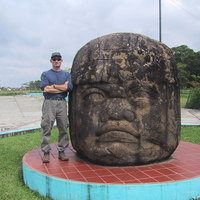- Geochronology & isotope Geology, Geoarchaeology and Lithic Studies, Geosciences, Anthropology, Archaeology, Climate Change, and 6 moreLandscape Archaeology, Archaeology of Mexico, Archaeology and History of North America, Archaeology of Disasters, Younger Dryas Boundary Impact research, and Geoarchaeology and geology of the Baja California Peninsulaedit
Effects of Medieval Climatic Anomaly on California Indian cultural patterns.
Research Interests:
Settlement of the Prairie Margin: Archaeology of the Richland Creek Reservoir, Navarro and Freestone Counties, Texas: 1980-1981 . L. Mark Raab. ; Historic Indian Groups of the Choke Canyon Reservoir and Surrounding Area, Southern Texas . T. N. Campbell, T. J. Campbell. ; Archaeological Investigat...more
Research Interests:
Research Interests:
... Finally, we will present examples of theory-building in archaeology that we believe more nearly conform to the original concept of middle-range theory, and point out why we believe these strategies better serve the needs of... more
... Finally, we will present examples of theory-building in archaeology that we believe more nearly conform to the original concept of middle-range theory, and point out why we believe these strategies better serve the needs of archaeology. 258 [Vol. 49, No. 2, 1984 Page 5. ...
Research Interests:
Occupied from ca. 7040 B.C. to A.D. 1400, the Eel Point Site (CA-SCLI-43) on San Clemente Island, California represents one of the longest sequences of near-continuous marine resource exploitation on the west coast of North America.... more
Occupied from ca. 7040 B.C. to A.D. 1400, the Eel Point Site (CA-SCLI-43) on San Clemente Island, California represents one of the longest sequences of near-continuous marine resource exploitation on the west coast of North America. Faunal remains suggest transitions from heavy exploitation of fur seals and sea lions during the early Holocene, to increased hunting of cetaceans at mid-Holocene, to a focus on sea otters and fish during the late Holocene. These trends are consistent with patterns of overexploitation and economic intensification on the California and Oregon mainland, but they also suggest watercraft-based hunting earlier on the island than elsewhere. Fur seal and sea lion bones mainly represent females and juveniles, indicating that exploitation of island rookeries was guided more by self-interest than by principles of game conservation. Two intervals of temporary site abandonment, ca. 6150–3970 B.C. and A.D. 1020–1400, were both followed by periods of increased marine mammal exploitation and may reflect intervals during which marine mammal populations rebounded. Broad-scale diachronic trends in the zooarchaeological remains do not correlate with flux in paleo-sea temperatures and are best interpreted as products of overhunting and increased use of watercraft over time.
